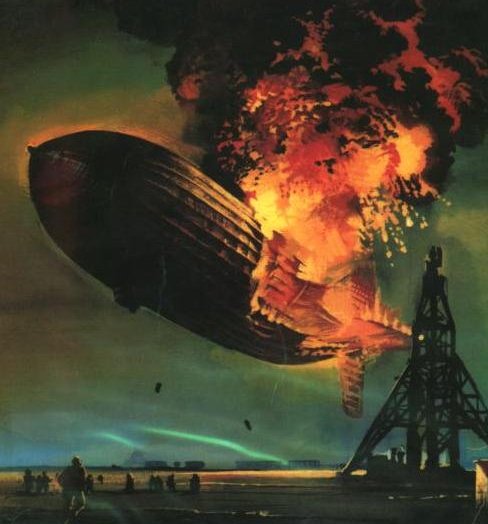
|
by Brett Lunde
Dr. Eckeners dream of a regularly scheduled Zeppelin airship service across the North Atlantic to America was finally realized with the construction of the Hindenburg. It was designed to carry 50 passengers in a luxury and comfort never before seen in Airship Travel. It was to be one of Nazi Germany's finest airships. The Hindenburg was supposed to represent the greatness of Germany and its leader, Adolf Hitler. Because of this the Hindenburg was emblazoned with large swastikas on itís vertical fins.
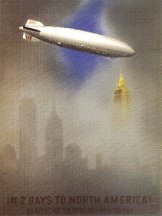
Picture of Hindenburg
with Nazi symbols on the fins
The Hindenburg would soon enter service-carrying passengers across Europe and North and South America. The Hindenburg was supposed to be the first in a fleet of Zeppelin owned airships, designed for commercial air travel across the Atlantic to America.

The largest flying man-made craft
On March 4, 1936, the largest man made object ever to fly, took to the air. The ship was to move very well through her trials with only a few bugs to work out and some repairs to make due to a poor landing. During its trials it made many propaganda flights over Germany dropping pamphlets and showing of the power of the Nazi movement.
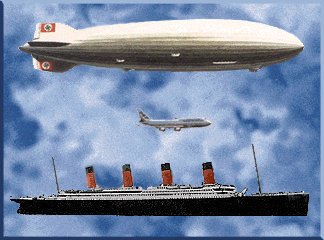
Hindenburg compared to the Titanic and today's airliner
Length: 804 feet / 245.06 meters Diameter: 135 feet / 41.15 meters Gas Volume: 7,063,000 cu. feet / 211,890 cu. meters Engines: Four 1200 hp Mercedes Benz engines Maximum Speed: 84.4 mph / 135 km/h Gas Type: Hydrogen |
The Hindenburg had many new innovations in airship design. Her complete design was a departure from older Zeppelin ships and carried many novelties. She would carry all her passengers inside her huge hull instead of from a protruding gondola section. Her control car alone would disturb her smooth lines. She was also fitted with a smoking room, something of an oddity on a ship destined to be inflated with an incredibly flammable gas. The smoking room was built with an airlock, which would keep any flames from spreading to the rest of the ship. The room was lined with asbestos.
On May 6, 1937, the great Zeppelin airship had made its first successful crossing of the Atlantic and planned to land at Lakehurst, New Jersey. With friends and family watching the arrival of the great lighter-than-air craft, it suddenly burst into flames while landing in the full view of the crowd which including reporters and newsreel cameras.
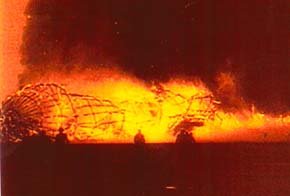
The Hindenburg completely engulfed in flames on the ground
Contrary to popular belief the crash was not broadcast live. Herbert Morrison of WLS radio of Chicago was at the landing site experimenting with recording news for delayed broadcast. He recorded his report, and then later played it over the air.

Hindenburg on fire
At the time, authorities blamed the disaster on a discharge of atmospheric energy near a leaking hydrogen valve. But others speculated that it was the result of anti-Nazi sabotage. Whatever the cause, the use of flammable Hydrogen has long taken the blame for the disaster, which effectively ended commercial travel by zeppelin.
The Hindenburg was originally built and designed to fly using non-flammable helium. But the United States was the only country that had helium and they had passed a law that did not allow them to trade with Nazi Germany. The United States government feared Hitler would use the helium for military purposes, so the Hindenburg was forced to fly using hydrogen.
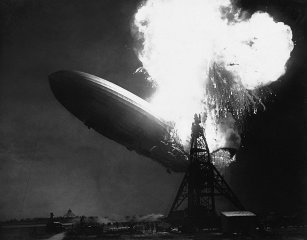
The Hindenburg Airship on fire picture taken from Lakehurst
The Hindenburg was a huge gamble in a long line of gambles for the Zeppelin Company. It still holds the record as the largest aircraft ever to fly, and was meant to be only the first of a fleet of commercial lighter-than-airships. History dictated otherwise.
Sources:"The Hindenburg Disaster" @ http://buffs.moviething.com/buffs/mechdon/index4.shtml, 05/05/00
"Hindenburg in Flames" @ http://hearitnow.umd.edu/1937.htm, 05/10/00
"Great Zeppelin Airships" @ http://www.ciderpresspottery.com/ZLA/greatzeps/german/Hindenburg.html, 05/09/00
"The Hindenburg." Comptonís Encyclopedia 2000 (CD-ROM), 2000.
Picture #1 - "Hindenburg Airship Disaster" from: http://www.vidicom-tv.com/tohiburg.htm
Picture #2 - "Hindenburg with nazi symbols on its fins" from: http://www.fbi.gov/foipa/hindburg.htm
Picture #3 - "Largest Man-made flying craft" from: http://www.fbi.gov/foipa/hindburg.htm
Picture #4 - "Hindenburg compared to Titanic" from: http://www.ciderpresspottery.com/ZLA/greatzeps/german/Hindenburg.html
Picture #5 - "Hindenburg completely engulfed in flames" from: http://www.otr.com/hindenburg.html
Picture #6 - "Hindenburg on fire" from: http://www.roadsideamerica.com/attract/NJLAKhinden.html
Picture #7 - "Hindenburg Airship taken from Lakehurst" from: http://www.vidicom-tv.com/tohiburg.htm